The Monument on Monument Hill
Close to where we picked up the Wessex Ridgeway is this imposing lion on a plinth. Pevsner reveals that the monument commemorates road improvements made in 1768 and that the lion has an iron tail. It is a nice straight stretch of road and perhaps it was an early example of a bypass (around the village of Stert)?
We started walking in a mixture of cloud and sunshine, greatly regretting that we had left in a rush and failed, for the first time ever, to pack a waterproof top layer. The view to the south over the villages of Urchfont, Easterton and Market Lavington was delightful.
After crossing Monument Hill, we find ourselves in less open country than on the previous leg. We enjoyed the sight of these fine oak trees just coming into leaf.
A little further on, a gap in the trees offered glimpses of Stert. The church of St James (rebuilt 1845-6) can be seen on the left and the thatched house in the centre had an intriguing round section on the left.
We crossed a railway line and headed towards Urchfont. There was a nice view back in the direction of Stert.
On the edge of Urchfont we were all impressed by the new buildings at Knights Leaze Farm, with a great setting on top of a hill. The curving roofs were especially impressive.
Pevsner observes that there are many attractive houses in the village, and this pair is fairly typical.
The area around the pond was clearly being prepared for an event of some kind, judging by the traffic signs and tents. The imposing house in front of the church is the early 19th century Manor Farmhouse. To the right, the redevelopment of another farm was underway.
We followed a muddy track which climbed steadily out of the village towards Urchfont Hill (215m). We were just on the edge of a hailstorm, but got away lightly. Just before the summit, the Wessex Ridgeway turns left (south west) offering lovely views of the villages in the valley below.
The final section simply followed a track along the ridge for about two miles to reach where we had left the car at the top of Lavington Hill. The views were great, but we were walking into a howling cold wind and it was hard to fully appreciate them.
Conditions: cloudy with some sunshine and hail, windy.
Distance: 6 miles.
Map: Explorer 130 (Salisbury & Stonehenge).
Rating: four stars.



















































